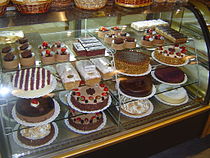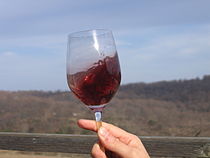- Argentine cuisine
-

This article is part of the series
Argentine cuisineRegional cuisinesCentral Region • Northwest • Cuyo • Northeast • Patagonia
Ingredients and types of foodIngredients • Main dishes • Desserts • Drinks
See alsoHistory • Etiquette • Argentine chefs • Cookbook: Cuisine of Argentina
 Argentina portal
Argentina portal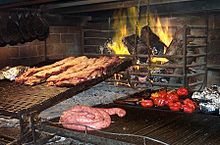 Typical Argentine Asado (grill).
Typical Argentine Asado (grill).
Argentine cuisine may be described as a cultural blending of indigenous Mediterranean influences (such as those exerted by Italian-Spanish and Arabic populations) with the wide scope of livestock and agricultural products that are abundant in the country.[1] Argentine annual consumption of beef has averaged 100 kg (220 lbs) per capita,[2] approaching 180 kg (396 lbs) per capita during the 19th century; consumption averaged 67.7 kg (149 lbs) in 2007.[3] Beyond asado (the Argentine barbecue), no other dish more genuinely matches the national identity. Nevertheless, the country´s vast area and its cultural richness have led to a local cuisine of many more dishes.[1]
Argentinian people are known for their love of eating.[1] Social gatherings are commonly centered on sharing a meal. In fact, inviting people to have dinner at home is usually viewed as a symbol of friendship, warmth, and integration. Furthermore, Sunday family reunions are generally an occasion to eat asado or pasta.[1]
Another feature of Argentine cuisine is the preparation of homemade food -- to celebrate an occasion, to meet friends, or, especially, to honor someone. The tradition of locally preparing food is passed down from generation to generation, and homemade food is also seen as a way to show affection.[1]
On the other hand, the scope of restaurant meals on offer is exceptional; people can choose among a great variety of cuisines, prices, and flavours.[1] Large cities count on unique gentrified restaurants offering international cuisine, and Argentina provides diners with other options, such as bodegones (inexpensive traditional hidden taverns), less stylish restaurants, and bars and canteens offering an enticing range of dishes at affordable prices.[1]
Contents
Typical foods
Culture of
Argentina
Architecture
Cinema
Comics
Cuisine
Dance
Holidays
Humor
Literature
Music
Newspapers
Painting
Radio
Sports
Television Dulce de Leche, a national obsession used to fill cakes and pancakes, spread over toasts and as an ice cream flavour.
Dulce de Leche, a national obsession used to fill cakes and pancakes, spread over toasts and as an ice cream flavour.
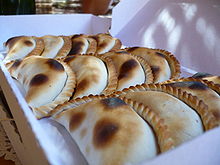 Empanadas hot off the oven.
Empanadas hot off the oven.
Argentines are famous for their high protein diet, particularly beef. Grilled meat from the asado (barbecue) is a staple, with steak and beef ribs especially common. Chorizo (pork sausage), morcilla (blood sausage), chinchulines (chitterlings), mollejas (sweetbread), and other parts of the animal are enjoyed. In Patagonia, lamb and chivito (goat) are eaten more frequently than beef. Whole lambs and goats can be seen on the asado. Chimichurri, a sauce of herbs, garlic and vinegar, is often used as an accompaniment. (Most Argentines have a relatively delicate palate and do not include chili in their version of chimichurri).
Breaded and fried meat (schnitzel)— milanesas — are used as snacks, in sandwiches, or eaten warm with mashed potatoes — purée. Empanadas — small pastries of meat, cheese, sweet corn and a hundred other varieties — are a common sight for parties, starters and picnics across Argentina. Another variation is the "empanada gallega" (Spanish empanada, known simply as "empanada" in Spain. "Galician/gallego" is a common adjective referring to Spain.), which has a round shape and is more like a big, round meat pie mostly made with tuna and mackerel ("caballa" in Spanish). Vegetables and salads are important too for Argentines, even beyond the fried or mashed potato. Tomatoes, onions, lettuce, eggplants, squashes and zucchini are common side dishes.
Just as much as beef, Italian staples, such as pizza and al dente pasta, are eaten. Fideos, Tallarines, ñoquis, ravioles and canelones can be bought freshly made in many establishments in the larger cities. Italian-style ice cream is served in large parlours and even drive-through businesses. In Chubut, the Welsh community is known for its teahouses, offering scones and Torta Galesa, which is rather like Torta negra.
Sandwiches de miga are delicate sandwiches made with crustless buttered white bread, very thinly sliced cured meat and cheese and lettuce. They are often purchased from entrepreneurial home cooks and consumed for a light evening meal.
Argentine food also reflects its European roots and sometimes varies in certain regions more than in others.
A sweet paste, dulce de leche is another national obsession, used to fill cakes and pancakes, spread over toasted bread for breakfast or as an ice cream flavour. Alfajores are shortbread cookies sandwiched together with dulce de leche or a fruit paste. The "policeman's" or "truck driver's" sweet is cheese with quince paste or dulce de membrillo. Dulce de batata is made of sweet potato/yam: this with cheese is the Martín Fierro's sweet. Apples, pears, peaches, kiwifruits, avocados and plums are major exports.
A traditional drink of Argentina is an infusion called mate (in Spanish, mate, with the accent on the first syllable). The dried leaves and twigs of the yerba mate plant (Ilex paraguariensis) are placed in a small cup, also called mate, usually made from a gourd, but also from bone or horn. The drink is sipped through a metal or cane straw called a bombilla. Mate can be sweetened with sugar, or flavored with aromatic herbs or dried orange peel to hide its bitter flavour. Hot water is poured into the gourd at near-boiling point so as to not burn the herb and spoil the flavour. At family or small social gatherings, one mate may be shared by the group, with the host preparing the mate to the preference of each guest. When one guest is finished, the mate is returned to the host, who will then prepare a mate for another guest. This is considered an important social ritual. Mate cocido is the same leaf, which rather than brewed is boiled and served, as coffee or tea, with milk or sugar to taste.
Other typical drinks include wine (occasionally mixed with carbonated water known as soda); tea and coffee are equally important. Quilmes is the national brand of pale lager, named after the town of Quilmes, Buenos Aires, where it was first produced.
Regional differences
Argentine cuisine is heavily influenced by its European roots. Asado, dulce de leche, empanadas and yerba mate are found throughout Argentina. In many parts of the country, food is prepared differently and different kinds of foods are made; this includes to a smaller degree food from pre-Columbian times, as in the Northwest.
Central region and las Pampas
Main article: Central Argentine cuisine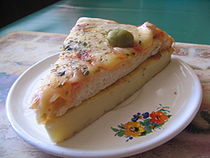 Sliced pizza served over fainá, a common combination.
Sliced pizza served over fainá, a common combination.
For lengthy time spans, urban areas such as Buenos Aires, Rosario and Córdoba welcomed European immigrants, including, above all, those of Italian and Spanish descent. Nevertheless, there was also a migratory flow of German, Swiss and Middle-Eastern immigrants arriving in Argentina. Among the countless changes this melting pot brought about, it can be argued that it similarly led to the enrichment of the culinary art. As a result, dishes such as pasta, pizza, polenta (cornmeal), stews, tortillas, pucheros (stews), croquetas (fritters), sauces, embutidos (sausages), chicken and meat courses caused daily menus to include a wider scope of options to choose from. Furthermore, the bread-making, desserts, pastries and dairy products industries have achieved a considerable development in this region.
As a matter of fact, eating the above mentioned dishes has developed a distinctively Argentine nuance. That is why, for example, the scope of pasta options comprises a wide variety of dishes ranging from spaghetti, fusiles (fusilli), ñoquis (gnocchi), ravioli and lasagne including cintas (pasta ribbons); the Argentine made sorrentinos, agnolotis, canelones (canneloni) and fetuchines (fetuchini).
As regards pizza, it is worth being dealt with separately. With very thin high-rising doughs, with or without cheese, cooked in the oven or a la piedra (on a stone oven), and stuffed with a countless scope of ingredients, it is one of those dishes that can almost certainly be eaten in almost every corner of this country. Buenos Aires, Rosario and Córdoba also serve it with fainá, which is a chick pea-flour dough placed over the piece of pizza. In fact, people say that what makes the Argentine pizza unique is the blending of Italian and Spanish cultures. At the turn of the 19th century, immigrants from Naples and Genoa opened the first pizza bars, though the Spanish subsquently took charge of the pizza business.
 Argentine pastry, including Rogel (a cake of layers of hojaldre covered with meringue), Dulce de Leche, and regional variants of Alfajores (from Mar del Plata, Córdoba, Tucumán, among others).
Argentine pastry, including Rogel (a cake of layers of hojaldre covered with meringue), Dulce de Leche, and regional variants of Alfajores (from Mar del Plata, Córdoba, Tucumán, among others).
With respect to bread products, their consumption is said to be widely spread all around the country. Additionally, the deeply-rooted bread, pastry and dessert-making tradition actually derives from blending the above nationalities' products. Therefore, it is not unusual to find bakeries at a countrywide level selling not only a wide scope of breads, cookies and cakes, but also pastries (the latter resembling a sort of roll pastry) whose main dough ingredient may be either butter or fat, and which may be simple or stuffed with dulce de leche (milk jam), crema pastelera, quince or apple jelly, among other fillings. The most popular type of pastry is said to be that of medialunas (based upon the well-known croissants). Furthermore, another type of bread products refers to sandwiches de miga, made only with thin layers of white bread (generally referred to as crustless bread) and stuffed with food items ranging from ham and cheese to other more sophisticated combinations such as raw ham, tomatoes, olives, hard boiled eggs, tuna, lettuce, red pepper, and the like.
Desserts and sweets are usually stuffed or covered with dulce de leche, which is made of milk and sugar. The latter can be usually eaten alone or on top of cakes, alfajores, panqueques (creppes) and pastries, or as a topping spread over flan. As to Chantilly cream, it is widely consumed and used in preparing sweets and desserts. Additionally, cakes, sponge cakes and puddings are very popular dishes. Italian ice-creams in this region also achieved a significant degree of development by adding local flavors that somehow preserved the local spirit involved in their preparation.
Even though the origin of asado may be traced back to the Pampas, it goes without saying that it may be eaten all over the country. In fact, it entails manifold types of meat which are generally eaten as follows: achuras (offal) (the cow´s inner parts) and morcilla (blood sausage) and sometimes also a provoleta, which is a piece of provolone cheese cooked on the grill with oregano, are eaten first. Then comes the choripán (a kind of spiced sausage made with pork or lamb and placed between two slices of bread), and lastly meat such as asado de tira, vacío (hindquarter) lomo (tenderloin), colita de cuadril (rump), matambre (Rolled stuffed steak cut into slices and served cold, entraña (innards), and the list is certainly never-ending. It is quite common to eat and enjoy a dish known as cabrito al asador (roast kid or goat) in the province of Córdoba.
Northwest and Cuyo
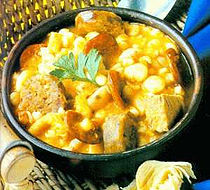 A bowl of Locro stew, a traditional standby in northwestern Argentina.
A bowl of Locro stew, a traditional standby in northwestern Argentina. Main articles: Argentine Northwest cuisine and Argentine Cuyo cuisineSee also: Argentine wine
Main articles: Argentine Northwest cuisine and Argentine Cuyo cuisineSee also: Argentine wineThis region is regarded as perhaps the one most influenced by native Indians, and this fact is clearly evidenced in its foods, which are closely linked to the Andean-Incan tradition. When preparing regional dishes, potatoes and corn or wheat are almost always used, including quinoa (a cereal typically used in Incan cuisine), peppers, squashes and tomatoes. The most celebrated dishes by far are humita and tamal, in which the corn husk is stuffed with the corn filling itself, seasonings or meat.
Nevertheless, this region is the most suitable scenario to taste empanadas, above all those stuffed with meat and offering different types of tempting varieties such as the meat empanada, salteña also filled with potatoes, or the empanada tucumana, which is stuffed with matambre and cut with a knife, or empanadas made with cheese. Empanadas are individually sized and closed savoury pastries which may be fried or baked in the oven and are generally eaten with the hands.
Stews such as locro, carbonada and cazuelas (casseroles) are also typical dishes characterizing this region, which also include pumpkin or potato pudding stuffed with meat.
Many of the sweets produced in this region, such as quince, sweet potato, molasses and cayote jams, have given rise to a very well-known and easily made dessert referred to as vigilante, or to so-called queso y dulce (where a piece of fresh cheese is served with one of the sweets mentioned above).
Mesopotamia
Main article: Argentine Northeast cuisineThis is another area influenced by native Indians, particularly by the Guaraní tribe. Abounding in rivers and shores, it offers an irresistible diversity of fish species, such as dorado, pacú, surubi, boga and silverside.
Widely grown in this area, cassava is typically included in the region’s dishes, as are other components of meals, such as the chipá (a cassava and cheese bread), which originally came from Paraguay. As regards products made with sugar, the mamon fruit (mamoncillo) jam is typical of the province of Corrientes.
The unmatched product in this region is certainly the yerba maté. Consumed countrywide, this product features a peculiarity of its own in this area: it is not only prepared with hot water, but, driven by the region’s high temperatures, it is common to see it prepared with cold water as well, in which case the beverage is known as tereré.
Patagonia
Main article: Argentine Patagonia cuisineMarine species such as salmons, spider crabs, squids and other shellfish and molluscs may be fished in this region's shores. Furthermore, trout may be found in Patagonian rivers.
Chocolate y dulce de leche cakes and other regional favorites in a San Martín de los Andes, Neuquén shop.
The diversity of red fruits grown in the area feature cherries, billberries, strawberries, rose hips and elders, which are made into jams and marmalades.
The Northern and Central European settlements in this region have built up a large-scale production of chocolate and its by-products, thus rendering them quintessential products in the region. Viennese and German cuisine and pastries are also typically associated with this region.
As far as meat is concerned, mutton and lamb, together with wild boar and venison all make up highly appealing dishes. Also typical of this southern region are smoked products, including salmon, stag, wild boar, and pheasant, among others.
Patagonia has also been exposed to the profound influence of native Indian tribes, in particular, those of the Mapuches and the Araucanos. A typical dish prepared by the latter is the curanto (a term meaning "hot stone"). Its preparation involves digging a hole about 150 cm deep in the ground, within which incandescent stones are placed inside a bonfire. A bed of nalca or maqui leaves is arranged on top of the stones, and the following ingredients are added, in turn, on top of this bed: beef, lamb, pork, chicken, chorizos (pork sausages), potatoes, sweet potatoes, apples and holed squashes filled with cheese, cream and peas. Subsequently, all these ingredients are covered with leaves and damp pieces of cloth so as to ensure heat preservation. Next comes a layer of plenty of soil, thus turning the whole arrangement into a genuine pressure oven. Wisps of smoke start billowing out of the ground when the cooking process has come to an end.
Alcoholic beverages
Though a review of the cuisine of Argentina and its principal regions has been assembled, with abundant information, it would be incomplete if the article mentioned only the foods and beverages already cited.
For example, though the importance of the production and consumption of wine (vino) has been discussed, it is important to note that beer (cerveza; the Italian birra is frequently used) in the second half of the 20th century (at the least) and in the first five years of the 21st, competes with wine in popularity. Breweries appeared in Argentina at the end of the 1860s, started by Alsatian colonists; the first were almost in the downtown of Buenos Aires (el égido de la Ciudad Autónoma de Buenos Aires), and soon Polish brewers began industrial production of beer: San Carlos in the province of Santa Fe, Río Segundo and Córdoba in the province of Córdoba, Quilmes (Quilmes beer) and Lavallol on the outskirts of La Plata (in Buenos Aires Province), San Miguel de Tucumán in the province of Tucumán and on the outskirts of the cities of Mendoza and Salta.
The local consumption of beer has risen dramatically in the last generation: Argentines consumed 233 million liters in 1980 and 1.57 billion in 2007 (40 liters per capita).[4] Outpacing that of wine since 2001, the growing production and consumption of beer has supported the existence of related events, for example the so-called Oktoberfests (sic) or "Fiestas de la Cerveza" in locations that have a significant German population (Villa General Belgrano in Córdoba, San Carlos and Esperanza in the province of Santa Fe, etc.). Such celebrations copy, in an Argentine manner, Munich's Oktoberfest, and similarly are tourist attractions. However, the presence of a vigorous population of Celtic lineage, principally of Irish origin, has supported the creation of other celebrations of beer, often for marketing purposes, such as Saint Patrick's Day (Día de San Patricio), patron of Ireland, which is celebrated with abundant libations.
The consumption of alcoholic beverages in Argentina is similar to that of the United States and somewhat lower than the Western Europe average.[5] Argentines enjoy a variety of alcoholic beverages and Argentina can boast a varied array of elaboraciones, whether industrial or artisanal. Besides beer and wine, Argentines frequently drink cider (here again, the heritage comes from Spain and Italy, more precisely from Asturias and Campania). Cider is the most popular beverage of the middle and lower economic classes at Christmas and New Year (the upper classes proverbially preferring to celebrate with locally produced champagne, although real old-line "creole" aristocrats will still drink cider, which is much more traditional).
Other widely consumed spirits are aguardiente (firewater) made from sugar cane, known as caña quemada ("burnt cane") or, simply, caña ("cane"). (Although "caña" is really derived from "cognac" and was traditionally used in old Argentina for any brandy, but especially peach brandy, caña de durazno.) A folkloric note about caña quemada: until June 21 it is traditional to drink caña quemada with ruda macho (a variant of common rue), it is supposed that this mixture prevents the flu and other illnesses. Caña competes, mainly in rural areas, with gin ("ginebra"—as in the Dutch kind of gin.)
There are many artisanally produced liqueurs (distilled, flavored alcoholic beverages) in Argentina, for example those flavored with orange, egg, anise, coffee, cherry and, inevitably, dulce de leche. The Hesperidina is a type of liqueur made from orange peels, invented in Argentina around 1890. One may also encounter chitronchelo or (in Italian) citroncello, based on lemon. This beverage arrived with immigrants from the Mezzogiorno, and is produced both artisanally and industrially (for example, at Mar del Plata).
Non-alcoholic specialties
 Café Tortoni, one of the many coffehouses in Buenos Aires. The consumption of coffee is very common (141 cups per capita, annually).[6]
Café Tortoni, one of the many coffehouses in Buenos Aires. The consumption of coffee is very common (141 cups per capita, annually).[6]
Argentines enjoy a wide variety of non-alcoholic infusions (although now and then both "families" are mixed; the yerbiao for example, is mate mixed with caña or gin). Among these, mate has long been the most widely enjoyed; in 2006, over 700,000 metric tons were harvested in Argentina, mostly for domestic consumption.[7]
The fact that mate is so prevalent in the Southern Cone, however, must not lure visitors into thinking that other infusions are rare in the region; in Argentina especially, given that there is a strong European cultural imprint, the consumption of coffee is very common (141 cups per capita, annually).[6] Chocolate infusions are also popular (the eating of chocolate is a Spanish influence—although the plant originated in Mesoamerica), this consumption grows during autumn and winter, or in the cold regions of the country; there are two dates where consumption of chocolate infusions is traditional in the primary educational centres: 25 May and 9 July, that is, the two national dates of Argentina.
English cultural influence (reinforced at the end of the 19th century and beginnings of the 20th by British contacts with the Far East) has also made the consumption of tea very common.
To conclude the summary of infusions consumed in Argentina, it must be said that medicinal herbs are common in the whole country; among the most popular are: chamomile, lanceleaf, boldo, poleo, peperina, carqueja, thyme, canchalagua, rue (macho and hembra, that is, "male" and "female"), mallow, rosemary, passion flower, bira bira, palán palán, muña muña, to mention only the main ones. Many of these herbs are also used in apéritifs and bitters, whether alcoholic or not.
Popular short-order dishes
Bar Britanico, Buenos Aires. These "bars" are typically more akin to British "pubs" and are popular at lunchtime.
Common restoranes or restaurantes and rotiserias nearly anywhere in Argentina today serve (into the small hours) quickly prepared meals that in the course of the 20th century came to be known as minutas, "short-order dishes." Some of the dishes included in the category of minutas are milanesas, churrascos, bifes, escalopes, tallarines, ravioles, ñoquis, although some are very typical of locations that sell food: "bifes a caballo" (beef steak with two fried eggs), "milanesa a caballo", "milanesa completa" (a milanesa with two fried eggs and a garnish of fries), "revuelto Gramajo", "colchón de arvejas", "suprema de pollo" (a kind of chicken milanesa), matambres, "lengua a la vinagreta" and "sandwiches" (sandwiches de miga).
The variety of "sandwiches" (called thus in Argentina, as opposed to the Spanish emparedado) are nearly infinite. The most common are those made of milanesa, baked ham and cheese, pan de miga, toast, pebetes, panchos, choripanes, morcipanes, etc.; from Montevideo comes a different species of sandwich called the lomito, even though it contains no goat meat.
Also worth mentioning are picadas, which are consumed at home or in bars, cafés, "cafetines" and "bodegones"; they consist of an ensemble of plates containing cubes of cheese (typically from Mar del Plata or Chubut), pieces of salame, olives in brine, french fries, maníes (peanuts), etc.; picadas are eaten accompanied by an alcoholic beverage ("fernet", beer, wine with soda, to give some common examples).
To conclude, it should be noted that the people of Argentina greatly enjoy helado (ice cream, sorbet, etc.), especially the Italian kind. This fondness is not new: from the time of the Spanish colonies there has existed a type of sorbet made from fallen hail or snow. (This has been documented; desserts were made with snow in Mendoza at the beginning of the 19th century.)
Eating habits
In most parts of Argentina, lunch is the biggest meal of the day. Most of the cities (excluding busy ones, like Buenos Aires) close for lunch time. This is when most people return home to enjoy a large meal. Traditional lunches in Argentina are long and well developed.
References
- ^ a b c d e f g [1], 'Argentine Gastronomy', June 6, 2008
- ^ National Geographic Magazine. March 1958.
- ^ http://www.comex.infobaeprofesional.com/notas/62697.html
- ^ Ministry of the Economy
- ^ http://www.who.int/substance_abuse/publications/global_status_report_2004_overview.pdf
- ^ a b El negocio del café en la Argentina
- ^ Indec:Instituto Nacional De Estadistica Y Censos De La Republica Argentina
External links
- SaltShaker - A daily exploration of the culture, food, and restaurants of Buenos Aires.
- Argentina on two steaks a day
- Cocina Pop - Video-recipes of typical argentinean recipes, for anyone to be able to cook a typical argentinean meal anywhere in the world.
South American cuisine Sovereign states Dependencies and
other territories- Aruba
- Bonaire
- Curaçao
- Falkland Islands
- French Guiana
- Categories:
- Argentine cuisine
- Argentine culture
Wikimedia Foundation. 2010.
Look at other dictionaries:
Argentine wine — Argentine wine, as with some aspects of Argentine cuisine, has its roots in Spain. During the Spanish colonization of the Americas, Juan Cedrón (or Cidrón) brought the first vine cuttings to Santiago del Estero in 1557, and the cultivation of the … Wikipedia
Cuisine of Argentina — This article was a former . The cuisine of Argentina is distinctive in South America because of its strong resemblance to Spanish, Italian, French and other European cuisines rather than the other Latin American cuisines. Indigenous gastronomies… … Wikipedia
Argentine beef — Beef is a key component of traditional Argentine cuisine.Current situationArgentina has the world s highest consumption rate of beef, at 68 kg a year per capita. In 2006, livestock farmers kept between 50 and 55 million head of cattle, mostly in… … Wikipedia
Cuisine Argentine — Sommaire 1 Plats 2 Desserts et sucreries 3 Boissons 4 Voir aussi // … Wikipédia en Français
Cuisine classique — is a style of French cookery based on the works of Auguste Escoffier. These were simplifications and refinements of the early work of Antoine Carême, Jules Gouffé and Urbain François Dubois. It was practised in the grand restaurants and hotels of … Wikipedia
Cuisine Brésilienne — La cuisine brésilienne est issue d influences européennes, indigènes et africaines. Plusieurs des techniques de préparation sont d origine indigène, mais ont été adaptées par les esclaves et les Portugais. Les esclaves exécutaient leurs propres… … Wikipédia en Français
Cuisine bresilienne — Cuisine brésilienne La cuisine brésilienne est issue d influences européennes, indigènes et africaines. Plusieurs des techniques de préparation sont d origine indigène, mais ont été adaptées par les esclaves et les Portugais. Les esclaves… … Wikipédia en Français
Cuisine Paraguayenne — La cuisine paraguayenne ressemble à la cuisine argentine, avec toutefois des spécialités propres : Plats Le manioc qui remplace parfois la pomme de terre et le pain. Le steak de bœuf (lomito). Le sandwich de lomito completo (avec œuf, jambon … Wikipédia en Français
Cuisine argentine — Sommaire 1 Plats 2 Desserts et sucreries 3 Boissons 4 Voir aussi Plats La cuisine argentine est renommée pour ses … Wikipédia en Français
Cuisine of Tegucigalpa — A restaurant in Tegucigalpa The cuisine of Tegucigalpa refers to the cuisine and restaurants of the city of Tegucigalpa, Honduras. Rice, beans, and tortillas are a staple of the Honduran diet, and there is little difference in quality between… … Wikipedia


